Chapter 10 Nutrition&Health PDF

| Title | Chapter 10 Nutrition&Health |
|---|---|
| Course | Biological Concepts |
| Institution | University of Southern Indiana |
| Pages | 21 |
| File Size | 1.4 MB |
| File Type | |
| Total Downloads | 79 |
| Total Views | 192 |
Summary
Professor - Baath, Gurkirat...
Description
Chapter 10: Nutrition & Health
Our dietary requirements vary according to: body size age sex level of activity state of health genetic differences & metabolism kilocalorie: amount of energy required to raise the temperature of one kilogram of water by one °C Macronutrients: o carbohydrates o proteins o lipids o nucleic acids Micronutrients: o minerals o vitamins o phytochemicals carbohydrates: (starches & sugars) made of carbon, hydrogen and oxygen o o o o o o
o
Sugar in Our Diets
o
How Does Sugar Contribute to Tooth Decay? o o
o
having a healthy balance of good and bad bacteria will prevent bad bacteria that cause diseases or tooth decay, help keep our breath fresh, inhibit plaque growth frequent use of harsh mouthwashes, such as those that claim to "kill" bacteria ---> these mouth rinses kill the good bacteria as well as the bad, and this leaves more room for unregulated bad bacteria to grow, therefore damaging our oral health and our immune system as bacteria extract energy from sugars in the mouth --> acids are produced --> these acids dissolve tooth enamel --> resulting in cavities
o o
bad bacteria - including biofilms: Streptococcus mutans, Tannerella forsythia, Porphyromonas gingivalis… good bacteria: S. sanguinis, S. oralis, Actinomyces naeslundii, Neisseria subflava, and Veillonella dispar)
Complex Carbohydrates
o o o
wheat, rice, oats, and corn, whole grain/cereal grains --> provide carbohydrates along with vitamins, protein, fiber, and minerals fruits & fruit product --> contain fructose/sucrose, vitamins, minerals and fiber vegetables --> contain carbohydrates, vitamins, minerals and fiber
Polar and Nonpolar Molecules
o
Polar Molecules
o
polar molecules: have an unequal distribution of electrons and thus have a slight charge (carbohydrates, proteins, and nucleic acids have many polar bonds - they tend to be soluble in water)
o
Nonpolar Molecules
o o
nonpolar molecules: have equal distribution of charge
o
Fats
o
o o
lipids: a broad group of naturally-occurring molecules which includes fats, cholesterol, steroids, phospholipids, and many others they do not dissolve in water function: store energy, form structural component of the cell membrane, serve as precursors of hormones, aid in vitamin (A, D, E, K) absorption when dietary lipids cannot be properly absorbed into cells --> they build up on blood vessel walls --> contributing to heart disease saturated fats: fatty acids that have single bonds usually solid at room temperature unsaturated fats: have double bonds as well as single bonds in their fatty acid chain which causes the molecule to bend usually liquid at room temperature monounsaturated - one double bond
polyunsaturated - multiple double bonds
o
Phospholipids
o o
Phospholipids: form an integral part of the cell membrane fatty acid part in nonpolar phospholipids part is polar proteins are embedded in the phospholipid bilayer
o
Cholesterol
o
cholesterol: an essential component of cell membranes brain and nerve cells, and bile (helps the body absorb fats and fat-soluble vitamins) the body uses cholesterol to make vitamin D and various hormones, such as estrogen and testosterone our bodies can produce all the cholesterol that we need (don’t need it in our diet) plant products are cholesterol free (except coconut oil's saturated fat --> is easily converted to cholesterol by the body)
Protein
o
protein: the building block of all life and is essential for the growth of cells
Amino Acids
amino acids: makes up proteins 20 compounds out of 20 amino acids, 8 amino acids cannot be synthesized by the human body these essential amino acids must be must be consumed in diet different combinations make different proteins
complete proteins: contain all amino acids that are essential in human diet
ex) animal proteins incomplete proteins: lack at least one essential amino acid that is required in diet ex) plant proteins except: soy protein
Vegetarians & Vegans
o
vegetarian diets - rich in carbs, fiber, vitamins, and minerals but deficient in certain amino acids unless several different plant proteins are consumed ovolacto vegetarians - vegetarian who does not eat animal flesh of any kind, but consumes dairy and egg products vegans - strict vegetarian who consumes no animal food or dairy products
Fiber
o
fiber: the indigestible part of plant foods that travels through our digestive system, absorbing water along the way and easing bowel movements, helps speed up the elimination of toxic waste through the colon aka roughage an increase in dietary fiber reduces the incidence of several cancer; reduces the level of blood cholesterol and the risk of heart disease and stroke; they prevent reabsorption of bile from the intestine a good diet should contain approx. 25-30 grams of fiber a day the average American eats less than half of that the change in the way wheat was processed into flour at the turn of century - from a crushing to a finer rolling process - accounts substantially for the depletion in dietary fiber bran has the highest fiber content ~25% - 45%
Why Should You Eat Fiber?
cardiovascular health: soluble fiber can help lower serum cholesterol levels by inhibiting the absorption of cholesterol blood sugar regulation: fiber helps to regulate or slow glucose absorption improves control of diabetes and blood sugars prevents constipation and diverticulitis: insoluble fiber adds bulk to stool, keeping stool soft and the bowels moving regularly diverticulitis: the formation of numerous tiny pockets, or diverticula, in the lining of the bowel can range from pea-size to much larger, are formed by increased pressure on weakened spots of the intestinal walls by gas, waste, or liquid weight loss: both types of fiber makes you feel full, without adding a lot of calories fiber rich foods tend to be low in fat too cancer prevention: fiber-rich foods contain phytochemicals, known to reduce cancer risks
fiber may also help detoxify cancer causes substances for overall health: foods with fiber also have lots of vitamins and mineral that our bodies need also helps our bowels to function properly on a regular basis and to prevent either diarrhea or constipation substantial amounts of fiber can be found in foods such as: all-natural cereals whole-grain breads beans fruits vegetables nuts
Vitamins
o
vitamins: a group of organic substances, present in minute amounts in natural food, that are essential to normal metabolism, insufficient amounts in the diet can cause different deficiency diseases function as coenzymes water soluble vitamins: vitamins that our bodies do not store vitamin C and all of the B vitamins these vitamins dissolve in water when they are ingested, then enter the blood stream we use what we need at that time, and excess amounts are excreted in the urine since they cant be stored, everybody needs a continuous supple of water soluble vitamins in order to stay healthy fat soluble vitamins: vitamins that are normally stored in the body vitamins A, D, E, and K when these vitamins are ingested, they dissolve in fat in a healthy digestive system, the body used what it needs at that time and stores the rest for future use excess of fat soluble vitamins A, D, E, and K can accumulate in the body's fat tissues over time and can be toxic Vitamin B12 - required for DNA synthesis & cell division Vitamin C, E, & A - are antioxidants Vitamin D - required for calcium absorption Vitamin K - required for the clotting of blood
Free Radicals
free radicals: highly reactive chemicals that have the potential to harm cells
they are created when an atom of a molecule either gains or loses an electron during cellular metabolism at high concentrations, free radicals can be hazardous to the body and damage major components of cells, including DNA, proteins, and cell membranes antioxidant vitamins: can neutralize the damaging effects of free radicals vitamins A, C, and E
o
Minerals
o
minerals: inorganic (non carbon containing) ions and atoms necessary for proper functioning of cells e.g.) sodium, potassium, chloride Iron - required for the synthesis of hemoglobin & as a cofactor for many enzymes Fluoride - prevents tooth decay Calcium - performs a number of basic functions in the body; keeps bones and teeth strong; functions in blood clotting, muscle contraction & nerve function, maintains a regular heartbeat
higher levels of exercise in women (aged 18-25) can increase their bone density and forestall the development of osteoporosis later in life
Phytochemicals
o
phytochemicals: plant derived chemicals in food that are associated with good health
o
lycopenes (tomatoes) alkyl sulfides (onions & garlic) flavinoids (red wine & green tea) curcumin (turmeric) phytochemicals are associated with lower long-term risks of heart disease and cancer
Nutrition Facts & the Food Pyramid
o
o
Digestive System
o
Mouth
mechanical digestion - mastication by teeth a chemical digestion - salivary amylase (breaks down starch) Ig A (antibody) and lysozymes produced by the salivary glands - kills bacteria
Esophagus: muscular tube that conducts food to the stomach
Stomach
stomach: the main product of the stomach is gastric juice gastric juice: a mixture of mucus, hydrochloric acid, and digestive enzymes mixed with food in the stomach to promote digestion hydrochloric acid is made in the stomach by combining hydrogen and chlorides (hydrochloric acid a strong acid) HCL function: kills invading micro-organisms entering the stomach pepsin enzyme: breaks dietary proteins into smaller peptides
Gastroesophageal Reflux Disease (GERD)
aka acid reflux millions of Americans experience heartburn or acid reflux at least once a month the most common adult chronic disease in the US
occurs when the lower esophageal sphincter is weak or relaxes inappropriately, allowing the stomach's contents to flow up into the esophagus conditions that increase your risk of GERD include: obesity bulging of the top of the stomach up into the diaphragm (hiatal hernia) pregnancy delayed stomach emptying factors that can aggravate acid reflux include: smoking eating large meals or eating late at night eating certain foods (triggers) such as fatty or fried foods drinking certain beverages, such as alcohol or coffee taking certain medications, such as aspirin
Peptic Ulcers
normally the lining of the stomach and small intestines is protected against the irritating acids by mucus produced in your stomach if this protective lining breaks down or not produced in enough amounts --> results in inflammation or an ulcer the following can also raise your risk for peptic ulcers: Helicobacter pylori drinking too much alcohol regular use of aspirin, ibuprofen, naproxen ,or other nonsteroidal anti-inflammatory drugs (NSAIDs) smoking cigarettes or chewing tobacco radiation treatments
Small Intestine
complete digestion & absorption of food takes place in the small intestine
villi: finger like folds of the small intestine that increase surface area for digestions and absorption of food
Liver
largest gland in the body processes digested food from the intestine controls levels of fats, amino acids, and glucose in the blood stores iron & vitamins bile is produced by the liver and it helps in the breakdown of fat emulsification: the breakdown of large fat globules into smaller, uniformly distributed particles
accomplished mainly by bile acids in the small intestine bile is stored in the gall bladder until needed in the small
intestine pancreas: secretes many enzymes necessary for digestion of food trypsin, pancreatic amylase, lipase, nucleases sucrase and lactase are brush border enzymes that are produced by the cells of the small intestine
Lactose Intolerance
deficiency of lactase enzyme lactose intolerance: the inability to digest significant amounts of lactose, the major sugar found in milk
Large Intestine
food is no longer broken down in the large intestine large intestine: absorbs water and electrolytes from the approximate 1.5L of chyme passing through it daily the colon absorbs vitamins which are synthesized by the colonic bacteria - such as Vitamin K, Vitamin B12, Vitamin B1, and Vitamin B2 compacts feces, and stores fecal matter in the rectum until it can be eliminated via the anus symbiosis: any type of interaction between two species living together mutualism: two species that live together benefit each other ex) colonic bacteria & us
Absorption
diffusion: substances diffuse from a higher to lower concentration gradient (no energy input is required) small uncharged molecules (H2O and O2) can diffuse directly across the plasma membrane facilitated diffusion: transport that is aided by protein carriers (channels) active transport: movement of molecules against the concentration gradient from an are of lower concentration to an area of higher concentration with an input of energy from the breakdown of ATP
endocytosis: large molecules/particles enter the cell by vesicle formation by the plasma membrane
Circulatory System
o
Blood
red blood cells (erythrocytes): transport oxygen in blood white blood cells (leukocytes): fight infections platelets: play a role in clotting of blood artery: transports blood away from the heart vein: carries blood towards the heart capillary: blood vessels with walls only one cell thick connect arteries with veins thin capillary walls allow oxygen, carbon dioxide, water, and salts to be exchanged between the blood and the tissues
Hepatic Portal System
hepatic portal system: the system of veins comprising the hepatic portal vein and few other blood vessels nutrients absorbed from the small intestine travel first to the liver for processing before continuing to the heart and the rest of the body
Heart
Atria: the 2 upper chambers of the heart ventricles: the 2 lower chambers of the heart
Atherosclerosis
Atherosclerosis: the buildup of fat deposits in the arteries
if a clot forms and blocks a narrow artery, a heart attack or stroke can result thrombus: a stationary blood clot embolus: a traveling blood clot High Density Lipoprotein (HDLs): transport cholesterol, phospholipids and triglycerides out of tissues to the liver which some are used for the synthesis of bile acids and can be excreted from the body if enough fiber is present in the tract elevated triglycerides can be due to physical inactivity, smoking, excess alcohol consumption, and a diet very high in lipid/carbohydrates (60% of total calories or more) people with high triglycerides often have a high total cholesterol level, including a high LDL (bad) level and a low HDL (good) level
Cardiovascular Disease
risk factors: smoking high-fat diets lack of exercise hypertension atherosclerosis high cholesterol levels genetic predisposition exercise, proper diet, weight loss, and stress reduction can reduce the above risks LDL is a necessary protein in the body --> transports cholesterol to cells for metabolism when there is an excess of LDL in the blood or when it undergoes structural changes from certain body stresses LDL can become harmful by accumulating in blood vessel walls
this can lead to blockages in arteries or unstable plaque build-up
Obesity
increases the risk for high blood pressure, heart disease, stroke, diabetes, and several cancers (colon, breast, and prostate) decreased exercise, increased calorie intake increased consumption of fatty foods fast food --> super size portions, fried foods, beverages, shakes ….
Eating Disorders
o
Bulimia nervosa
bulimia nervosa: marked by binge eating huge amounts of food (up to 20k calories) and then purging it from the body by self-induced vomiting, enemas, laxatives, diuretics, or excessive exercise causes esophageal injuries, tooth decay, & gum disease resulting from frequent vomiting; dehydration, constipation, electrolyte imbalance
Anorexia nervosa
anorexia nervosa: a life-threatening eating disorder that is characterized by self-starvation and excessive weight loss causes severe decrease in bone health, amenorrhea (cessation of menstruation), malnutrition, and low body weight and poor bone health
Muscle Dysmorphia ("Bigorexia")
most commonly seen in males muscle dysmorphia: obsession with muscle size and developing very large muscles characterized by anabolic steroid abuse
Kwashiorkor
Kwashiorkor: a form of sever protein malnutrition characterized by edema, irritability, a distended abdomen, thinning hair, loss of teeth, skin depigmentation occurs in areas of famine or poor food supply results from inadequate protein intake...
Similar Free PDFs

Chapter 10 quiz #10
- 3 Pages

Notes 10 - Chapter 10
- 5 Pages
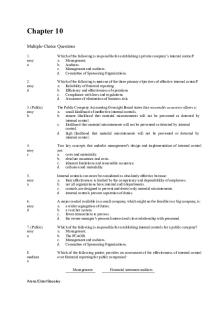
Chapter-10
- 19 Pages
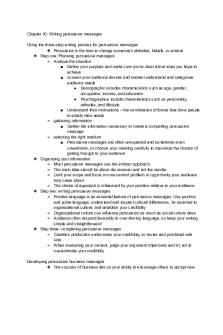
Chapter 10
- 5 Pages
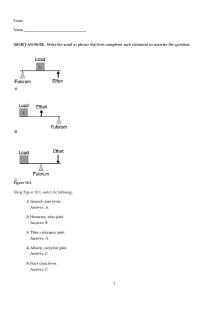
Chapter 10
- 14 Pages

Chapter 10
- 111 Pages
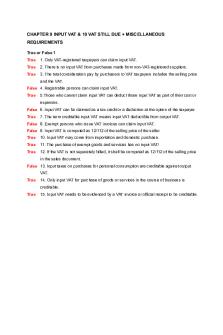
Chapter 10
- 16 Pages
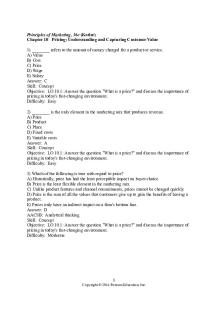
Chapter 10
- 47 Pages
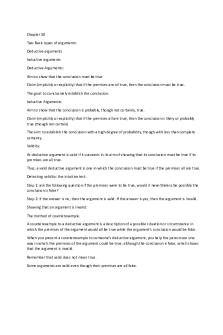
Chapter 10
- 4 Pages
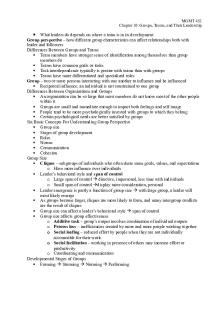
Chapter 10
- 5 Pages
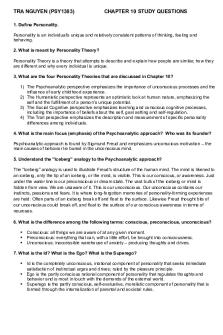
Chapter 10
- 6 Pages

Chapter 10
- 13 Pages

Chapter 10
- 10 Pages

Chapter 10
- 3 Pages

Chapter 10
- 22 Pages
Popular Institutions
- Tinajero National High School - Annex
- Politeknik Caltex Riau
- Yokohama City University
- SGT University
- University of Al-Qadisiyah
- Divine Word College of Vigan
- Techniek College Rotterdam
- Universidade de Santiago
- Universiti Teknologi MARA Cawangan Johor Kampus Pasir Gudang
- Poltekkes Kemenkes Yogyakarta
- Baguio City National High School
- Colegio san marcos
- preparatoria uno
- Centro de Bachillerato Tecnológico Industrial y de Servicios No. 107
- Dalian Maritime University
- Quang Trung Secondary School
- Colegio Tecnológico en Informática
- Corporación Regional de Educación Superior
- Grupo CEDVA
- Dar Al Uloom University
- Centro de Estudios Preuniversitarios de la Universidad Nacional de Ingeniería
- 上智大学
- Aakash International School, Nuna Majara
- San Felipe Neri Catholic School
- Kang Chiao International School - New Taipei City
- Misamis Occidental National High School
- Institución Educativa Escuela Normal Juan Ladrilleros
- Kolehiyo ng Pantukan
- Batanes State College
- Instituto Continental
- Sekolah Menengah Kejuruan Kesehatan Kaltara (Tarakan)
- Colegio de La Inmaculada Concepcion - Cebu
